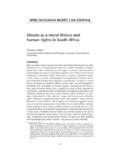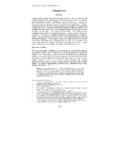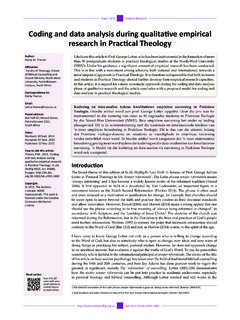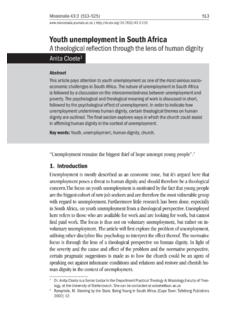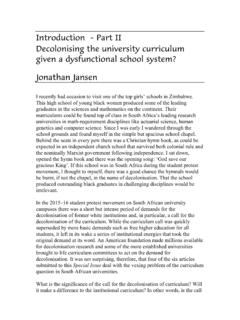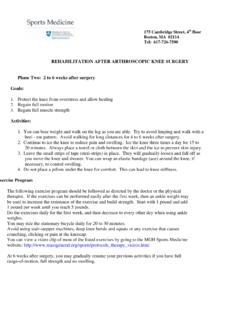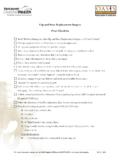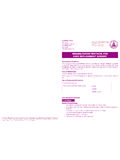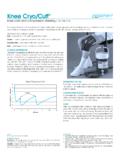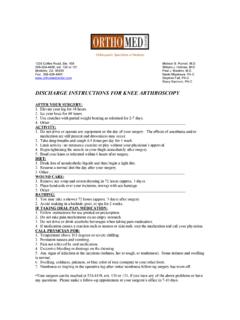Transcription of Knee pain, swelling and stiffness after total knee …
1 knee pain, swelling and stiffnessafter total knee replacement : a survey of South African knee surgeonsBR Garrett, MBBCh (Wits)Registrar, Department of OrthopaedicsJ Walters, FC(Orth) SAProfessor and Head of OrthopaedicsGroote Schuur Hospital, Department of Orthopaedic Surgery, University of Cape Town, Cape Town, South AfricaReprint requests:Dr B GarrettDepartment of Orthopaedic SurgeryH49 OMBG roote Schuur Hospital7925 ObservatoryCape TownCLINICALARTICLECLINICALARTICLESA ORTHOPAEDICJOURNALW inter 2010 / Page 59 Abstract knee pain, swelling and stiffness after total knee replacement (TKR) surgery are well-recognised , in some cases, despite investigation, the cause may be unexplained.
2 This study, using a questionnairesent to South African orthopaedic surgeons, examined the perceived incidence of unexpected knee pain andswelling after a straightforward TKR, aiming to identify possible associated or contributory factors. Of the 61respondents, two-thirds had more than 10 years experience and close to three-quarters performed 20 or moreTKRs per annum. Less-experienced surgeons report a greater frequency of unexpected pain than more-experi-enced surgeons (90% vs 53%) (p< ).Similarly, surgeons using the visual analogue scale (VAS) to assess apatient s pain also have a greater awareness of unexpected pain. Two-thirds of surgeons reported finding morepain than had been anticipated in between 6% and 20% of their cases.
3 Unexpected swelling is also an one-half of surgeons could identify the cause for pain in less than 5% of their cases. Surgeonswho use drains and have shorter surgical times reported a reduced incidence of unexpected pain and swelling ,although this did not reach statistical significance. No suggestive relationships were found for other peri-oper-ative parameters such as analgesic regimens, thrombo-embolic prophylaxis or mobilisation protocols. IntroductionTotal knee replacement (TKR) surgery has revolutionisedthe care of patients suffering from degenerative or inflam-matory arthritis of the knee . The goal of treatment is apain-free, stable knee joint which allows good functionfor activities of daily living.
4 There are a myriad causes for a poor outcome. Often theclinical picture is a spectrum of both pain and stiffness ,but many authors report one or the other as the predomi-nant symptom. The prevalence of postoperative pain andstiffness varies in the literature. Studies quote figuresfrom to (Table I). The overlap between painand stiffness varies between papers, and there is an inconsistent definition of stiffness which varies from 70 to 95 of may be associated with bothof these groups but it was not reported as an outcome inour literature the Orthopaedic Department at the University ofCape Town it has been recognised that some patients forwhom the results were anticipated to be excellent after anominally simple and straightforward TKR had muchmore pain and swelling than was expected.
5 This delayedtheir rehabilitation, decreased their range of motion, pro-longed their hospital stay, and correlated with a poormedium-term outcome. For many of them a specific causefor their pain and swelling could not be Winter 2010 4/30/10 5:41 PM Page 59 Page 60/ SA ORTHOPAEDICJOURNALW inter 2010 CLINICALARTICLEW hether this is inherent to the patient s response to the sur-gical assault, or as a result of a preventable cause, are twopossible options to explain this aim of this study was to assess the perceived incidenceof these problems among knee surgeons in South Africa andto see whether any surgical or other peri-operative interven-tion or variable appeared to play a role in the presence ofpostoperative pain.
6 swelling and study was conducted via a survey dealing with peri-operative management practices of South AfricanOrthopaedic Surgeons performing TKRs. A comprehensivequestionnaire was sent to members of the South AfricanOrthopaedic Association (SAOA), focusing on the sur-geon s perception of unexpected and unexplained postoper-ative pain and this, the intention is to perform a prospectivestudy guided by recommendations arising from this and methodsA survey of South African knee surgeons was performedusing the database for the South African OrthopaedicAssociation (SAOA). Of the 550 members, 150 were stillin training or no longer actively performed knee arthro-plasty.
7 One hundred-and-twenty surgeons on the databasehad incomplete or inaccurate contact email 280 questionnaires were sent to generalist and spe-cialist surgeons who perform total knee replacements. QuestionnaireFollowing a pilot study assistance for the design and datacontent was obtained from a biostatistician. The questionscovered multiple aspects of peri-operative assessment andcare of a patient after a total knee replacement (TKR),including the following: surgeon demographics, implantvariations, operative techniques including use of tourni-quets,haemostasis and drainage,medical interventionsincluding analgesia, anticoagulation and antibiotic use.
8 Theincidence of more pain than was expected and the abilityto identify causes for that pain were also examined, as wasthe occurrence of more swelling than was expected and theassessment of that swelling . The investigation of infection,the mobilisation programme, and the consideration ofmanipulation for stiffness were also definitionsFor the purpose of this study the following definitions ofterms used as relating to symptomatology apply. Unexpected implies a subjective assessment of suchoccurrence in the experience of the observer. Unexplained implies a symptom which cannot beshown to have a demonstrable questionnaire was converted into an Excel-basedspreadsheet for email communication and online comple-tion.
9 The respondents were grouped according to theirresponse to the questions on pain and comparative analysis of the variations in peri-operative parameters in these groups was then performed. ResultsOf the 280 questionnaires sent out, 61 respondentsreturned a completed questionnaire (22%). Thirty-two percent of the respondents were also members of the SouthAfrican knee Society. Ninety-two per cent (56/61) ofreporting surgeons practise in the private sector. Less-experienced surgeons (<10 years) comprised 34% (21/61)and surgeons with more than 10 years experience madeup 66% (40/61).The number of cases performed each year was alsotaken as a measure of experience, with 17 (28%) per-forming fewer than 20 TKRs per year.
10 Only eight (13%) high-volume surgeons performed more than 100 casesper year. Thirty-five per cent performed 20 50 cases peryear, and 23% between 50 and 100 cases per were asked to indicate the technique/implantwhich they used most frequently. Sixty per cent usedmobile bearing knees. Twenty per cent retained the poste-rior cruciate ligament. Only 18% routinely resurfaced thepatella. Computer-assisted surgery was regularly used by15% of respondents for their cases. Sixteen per cent ofsurgeons perform an average knee replacement in underan hour, with only another 16% typically taking longerthan 90 minutes.
